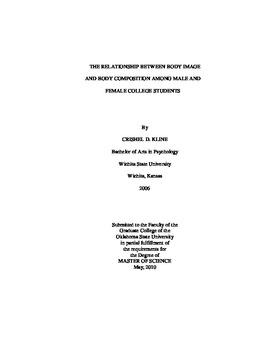| dc.contributor.advisor | Smith, Douglas B. | |
| dc.contributor.author | Kline, Crishel D. | |
| dc.date.accessioned | 2014-04-16T03:11:39Z | |
| dc.date.available | 2014-04-16T03:11:39Z | |
| dc.date.issued | 2010-05-01 | |
| dc.identifier.uri | https://hdl.handle.net/11244/9761 | |
| dc.description.abstract | The purpose of the present study was to investigate the relationship between body composition and body image among male and female college students. All participants signed an informed consent and completed a Medical History Questionnaire prior to taking part in the study. Participants were then asked to complete the Multidimensional Body-Self Relations Questionnaire (MBSRQ) before undergoing a seven-site skinfold measurement. Body Mass Index (BMI) was calculated using self-report height and weight numbers taken from the Medical History Questionnaire completed by each participant. Statistical analyses were run using the data collected comparing male and female participants. The results of the present study indicated that there was a significant difference for males in the AE, FO, HO, BASS, and SCW subscales of the MBSRQ when compared to percent body fat. The AE, FO, and HO subscales were negatively correlated with percent body fat (p<0.01) among males. The BASS subscale was also negatively correlated with percent body fat (p<0.05) for this group. The SCW subscale was positively correlated with percent body fat (p<0.01) for male participants. Percent body fat did not correlate with BMI values among male participants (p<0.01). Body image scores and percent body fat were compared among females using Pearson Correlation Coefficients. Significance was discovered in both the SCW subscale and the AE subscale of the MBSRQ when compared to percent body fat. A positive correlation was found among female participants when comparing SCW with percent body fat (p<0.01). When comparing AE with percent body fat, a negative correlation was found (p<0.05) in this group. Percent body fat did correlate with BMI values among female participants (p<0.01). The findings of this study suggest that body composition may affect body image in male and female college students. The results also suggest that percent body fat may be a more accurate method of assessing body composition than BMI measures. | |
| dc.format | application/pdf | |
| dc.language | en_US | |
| dc.publisher | Oklahoma State University | |
| dc.rights | Copyright is held by the author who has granted the Oklahoma State University Library the non-exclusive right to share this material in its institutional repository. Contact Digital Library Services at lib-dls@okstate.edu or 405-744-9161 for the permission policy on the use, reproduction or distribution of this material. | |
| dc.title | Relationship Between Body Image and Body Composition Among Male and Female College Students | |
| dc.type | text | |
| dc.contributor.committeeMember | Edwards, Steven | |
| dc.contributor.committeeMember | O'Brien, Matthew | |
| dc.contributor.committeeMember | Patterson, Jeremy | |
| osu.filename | Kline_okstate_0664M_10922.pdf | |
| osu.college | Education | |
| osu.accesstype | Open Access | |
| dc.description.department | School of Teaching and Curriculum Leadership | |
| dc.type.genre | Thesis | |
| dc.subject.keywords | bmi | |
| dc.subject.keywords | body composition | |
| dc.subject.keywords | body image | |
| dc.subject.keywords | mbsrq | |
| dc.subject.keywords | skinfold measurements | |
